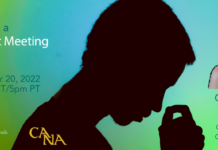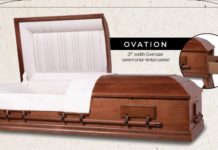By Leader Contributor Alexandra Jo, Culture and Content Manager at Parting Stone
Many funeral homes still consider the low-cost/low-profit margin of cremation to be a hurdle to overcome in their business.
For years, funeral industry professionals and the general public alike have turned to cremation as a “cheap option” when it comes to disposition. However, we are beginning to see an expansion in how the deathcare industry is framing cremation for families. Cultivating meaningful, immersive experiences around cremation in order to shift the perceived value of cremation services could be an impactful way to make cremation a pillar of a healthy funeral business.
When shifting public perception about the value of cremation, it’s important to understand the impact that aesthetics have on perceived value. Research shows that aesthetics (visual appeal communicated through design and branding) play a huge role in a person’s decision-making process, in determining how much something is worth, and how much they are willing to spend. Learning the basics of how to curate aesthetics that communicate value and worth around cremation services and experiences will go a long way in elevating the perceived value of cremation in the public eye, which will ultimately raise the bottom-line value of cremation across the funeral profession.
Perceived Value and Cremation
Cremation has historically meant “direct cremation,” which means the cremation service itself and a basic cremation container. However, funeral directors today are beginning to see the inherent problems with this limited business model. We now know that a wide range of memorial services and experiences are possible with cremation that traditionally have not been included in the direct cremation race-to-the-bottom strategy. Funeral homes that have failed to offer these expansive options and services and educate families on ways to make cremation a meaningful experience have contributed to the devaluing of cremation at large in the eyes of the general public.
To better understand the importance of perceived value, we should look at how perceived value is defined in terms of sales and business. According to this article from Air Call, “A customer buys a product for the perceived benefit he will gain from it. This perceived benefit, in addition to his opinion of the product, is what creates customer perceived value […] Perceived product benefits exist on three levels: physical, logical, emotional. For example, buying a new suit will help you stay warm (physical), land the new job for which you are interviewing (logical), and save you from the embarrassment of walking around naked (emotional). Perceived costs include money, time, and labor. When comparing the difference between perceived benefit and perceived cost, if the difference is positive, customer perceived value is high, meaning customers will buy a product or service.”

By educating families on how cremation services and experiences can be meaningful and personal, we help them better understand the value of those services. The way that we as funeral professionals communicate and cultivate cremation experiences goes a long way toward elevating the perceived value of those services to the general public.

Aesthetics and Perceived Value
Aesthetics in marketing and design typically refers to the visual impact of a company or product. According to an article from BBC, “Aesthetics refers to the way a product looks and feels. The first impression of a product is often visual, making aesthetics very important.” Thus, aesthetics are an important factor to consider when selecting products and services to offer along with cremation, as the visual impact of those products and services directly impacts their perceived value in the eyes of families.
According to an article from Medium.com:
“Aesthetic design does impact the perception and ultimately the value of a brand […] Veryzer (1993) conducted a study that revealed that aesthetic design principles impact a variety of consumer products including microwaves, suntan lotion, and sound machines. An increase in the aesthetic appeal of a product’s design has potential to greatly increase perceived quality of a product across a variety of sectors […] The aesthetic design of a product’s packaging also impacts the beliefs about a product.”
Another study from the Independent Journal of Management and Production found that aesthetics had a significant impact on perceived value and emotional value and directly had a positive effect on consumers’ decisions to purchase products. There are already many companies that offer cremation experiences with well-designed, intentional aesthetics around their cremation products and services. Click below to learn more about them:
Aesthetics and Cremation: Where Did We Go Wrong?
According to some funeral professionals, one seemingly innocuous cremation product has actually played a huge role in the public’s perception of cremation as a cheap and low-value option: the black box temporary container.
The black box was invented to solve a simple business problem: How can we return ashes to customers in a way that does not discourage urn sales? However, it’s possible that the unappealing aesthetics and poor design of the black box have been detrimental to the way that modern families perceive the value of cremation.
According to Justin Crowe, founder and CEO of Parting Stone, solving the black box’s aesthetic problems and finding a better solution for temporary cremation containers can go a long way towards shifting public perceptions around cremation:
“Deciding how to return cremated remains to customers is a design problem (and I am a design junkie). How do you take something repulsive and give it a sense of value? Packaging has a huge impact on how people feel about content. The customer desperately wants to cherish and love this pile of gray matter, so even a small effort should satisfy them. A good solution will ultimately make the grieving process smoother for the family, shape their overall outlook and value-assessment of the cremation experience, and make them love your funeral home’s services.
If a person handed me my dead mother in a zip-tied plastic bag in a plastic box with a frustrating latch I would never ever want to see them again. Your families will acknowledge the container you choose every day for the next 5-10 years and the current solution looks marginally better than a cereal box.
I believe the temporary cremation container has contributed massively to the current cremation price-gouging war fueled by suspicious customers who place no value on cremated remains. Providing the black box communicates: ‘We think this box accurately represents the value of cremated remains and that is what you should think about them too.’ It’s not a surprise, then, that customers want a $200 cremation and a $25 urn – we’ve been priming the public to expect this level of value for the past 70 years.”
Justin’s company, Parting Stone, also identified cremated remains themselves as having a problematic experience for families. In response, their service provides a complete alternative to cremated remains called solidified remains — 100% of the remains as “stones.” To learn more about Parting Stone and how offering solidified remains can empower your families and grow your business, sign up for Parting Stone’s monthly webinar here.
Revolutionizing Aesthetics in Deathcare
Another example of a funeral business taking steps to solve the aesthetic problem of the traditional black box is Oklahoma City Cremation. Darin Corbett, Managing Director of Corbett Funeral and Cremation and Oklahoma City Cremation, saw the need for a better temporary urn and turned to his community to problem-solve and find a solution. The custom temporary urns used by Oklahoma City Cremation are intentionally designed based on feedback directly from families. They are white, clean, professionally designed and labeled, cylindrical with a secure screw-on lid.
Darin explains the value of improving the temporary urn designs on the Deathcare Decoded podcast:
“Our company’s purpose is to reduce stress and reduce effort wherever we can because oftentimes we can see those stressors and traps before a family does. And this was one of them: ‘What do I do with this box?’ It’s not pretty, so families wanted to hide it, and it didn’t make whatever that final thing they were going to do with the cremains any easier. I thought this might be just a small problem for families, but it turns out that so many families like it […]
These containers meet our needs too … We were able to brand this free custom transport urn that has the person’s name on it, it’s done professionally, and it’s just a step above. So now I can actually have something branded that goes out and meets the families’ needs, and our business needs. And the way that we buy them, it’s actually less expensive than those black boxes. So, from an economic standpoint, it also makes sense; we just looked at it differently.”

Oklahoma City Cremation solved more than a problem of aesthetics by improving their temporary urn. Their families can travel with cremains more easily, the container can be buried more efficiently (it’s the exact dimensions of a standard post hole digger), and help families understand that cremation can be a deluxe service. None of these improvements have impacted urn sales but have in fact helped the families that Darin serves see a higher inherent value in other products and services that go along with cremation. This simple aesthetic improvement has helped bolster business for Oklahoma City Cremation.
Integrating Aesthetics and the Cremation Experience
The takeaway for funeral professionals is that aesthetics matter when it comes to elevating the perceived value of cremation services. Carefully curating cremation experiences that include services and products with clear messages and strong, appealing aesthetics and branding will help families understand that cremation is just as meaningful, important, and valuable as burial or any other disposition method.
To learn more about cremation services and experiences with strong aesthetics and branding that cremation families will love, click below to download a free ebook guide to strong aesthetics and design in deathcare:







